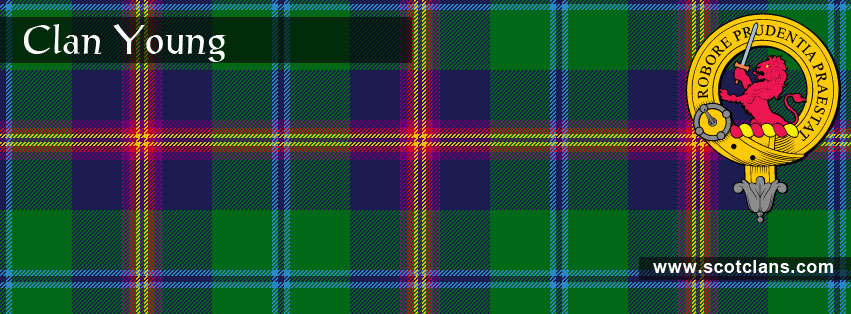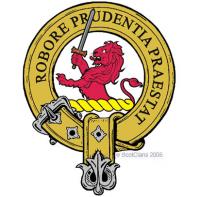
Clan Young
The name Young was originally used to distinguish a son from his father when they shared a common forename. It was also used in the case of multiple sons by the father's heir. Consequently this is a fairly common surname in Scotland, being frequently found in the Borders region and also the Northeast regions of Angus and Kinkardineshire.
Youngs in the Borders
It is not known when the Youngs really began to grow in significant numbers in the Borders area between Scotland and England, though it probably happened some time during the mid-Middle Ages. However, surnames in the area weren’t used until perhaps the beginning of the 14th century at the earliest.
During the rule of David I (1124-1153), a number of families settled in the Borders, including the progenitors of the Brouns, Kerrs, and the Comyns, and very possibly the Youngs too. Although the name Young suggests Anglo origin, there is likelihood that it could be claimed to be of Norman ancestry like the names of the aforementioned Brouns, Kerrs, and Comyns.
The Youngs were predominately found in the Middle March area of the Borders, and like many of the families living in the Marches, the Youngs took part in raiding parties on neighbouring villages and settlements on both sides of the border. These gangs, known as Border Reivers, raided along the Scottish-English border between the end of the 13th century and the beginning of the 17th, and although the Youngs in themselves were not a large family, they would associate themselves with larger gangs, such as the East Teviotdale reivers. A number of ‘Yonges’ recorded as having been raiders at one time include Blackhall Jock, Hobb of the Bog, Hob the Gun, and Tom the Gun. Some would assume that Hob and Tom were considered to have been skillful marksmen. The lawlessness of the region produced tough and resourceful fighters who were often relied upon to help defend Scotland in times of need.
Very few written records still exist from the Middle Ages of Scotland. It wasn’t until 1501 that the printing press arrived in Scotland, and so before then everything had to be hand written, and copies were rarely made. So, if any record handwritten was destroyed or lost, then it most likely would be gone forever. And in the belligerent times of the Middle Ages, it wasn’t uncommon to see castles and churches destroyed, along with any documents.
However, there are a few records prior to 1500, with reference to the Young name, that can be found. There is a mention of a Roger Yung in the English document ‘Calendar of Documents Relating to Scotland’. It records Yung as a “Scottish gentleman” who, along with a number of other Scots committed an offence to the English King Edward III during the reign of David II (1329-1371). It goes on to say that Roger Yung was released from the Tower of Berwick on the 10th of October, 1335.
There are records of a tenant farmer near Moffat called John Young in 1343, and of a different John Young who was a farmer in Raynpatrick in 1374. In the Registrum Cartum Abbacie Tironensis de Kelso (Register of the Charters of the Abbey of Kelso) there is a rather unclear record of a Roberto (Robert) Yong from Roxburghshire who had some sort of role in the transfer of the ownership of a barony in 1466.
The Parliamentary Rolls of 1587 have one of the first records of Border Clans, however, for one reason or another, the Youngs are not mentioned. There is no obvious reason why, but it has been suggested that they just weren’t big enough holders of land from the Crown at the time. Though not all historians agree with this. However, ‘Moneypenny’s Chronicle’, first published in 1597, does acknowledge the Youngs as a prominent family of the Borders.
Moneypenny suggests that the Youngs in fact held no land from the Crown, and instead they were tenants of either Lords or large abbeys in the area, and this is why they weren’t included in the Parliamentary Rolls ten years previously.
The Youngs at the time were known as ‘Gentlemen’; a title used in Britain as a type of nobility, separating them from the commoners of the area. The term ‘gentleman’ meant that the person was landed, or from a landed family, not that he necessarily acted in gentlemanly way.
The Youngs were one of the families that lived practically on the border with England, an area that saw some of the bloodiest skirmishes in British history. Several major battles were fought within 25 miles of the Young heartland, these include: Halidon Hill, 1333; Otterburn, 1388; Homildon Hill, 1462; Flodden Field, 1513; Ancrum Moor, 1545; Reidswire, 1575; and Philiphaugh in 1645. This means that the Young family over centuries almost certainly played a role in these major battles of history.
Youngs in the Northeast
In the northeast Youngs held various important positions such as sheriffs and military leaders. They were granted many lands and occupied various well-appointed castles, including Auldbar.
The earliest documented occurrence of the name was a John Young in Strachan, Kincardineshire who received a charter to the lands and castle of Carmylie, in Angus in 1325
Between 1325 and 1327, Richard Young was granted the lands of Ardin and Thorne for services given defending Forfar.
Around the same time, Ralph Young is recorded as one of the first Lord Provosts of Crail.
Peter Young was the son of merchant, born in Dundee in 1544. In 1569 he was made tutor to the infant King James VI, and later became Almoner to the King. He was knighted in 1605 after many years of service in various embassies.
Sir Peter had several children - one of them, Peter, served at the Swedish Embassy and another was granted extensive land in Ireland, where the name can now be found in the counties of Londonderry, Antrim, Tyrone and Down.
Another son, James, became a Gentleman of the King's Bedchamber, and he later had a son, Peter II. In 1670 Peter II purchased the Barony of Auldbar near Angus, which the family held for three generations. In 1753, Auldbar was sold to the Chalmers family after Robert II was said to have accidentally drowned while swimming just a few days before his wedding was due to take place. Since this time the chiefship of the clan has been vacant.
Successful Youngs in recent history include James Young who was born in 1811. He enjoyed a successful career as a chemist, most famously discovering how to extract paraffin from coal and shale.
George Younger, born in 1851, became chairman of the brewing company founded by his great-grandfather of the same name. He went on to become a successful politician and in 1923 was created 1st Viscount Younger of Leckie. His great-grandson was also George Younger (4th Viscount of Leckie), who was Secretary of State for Scotland and Defence Secretary in Thatcher's government, later becoming chairman of the Royal Bank of Scotland.









